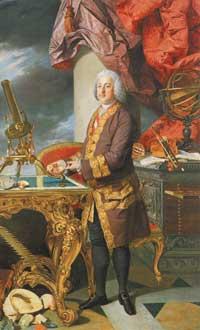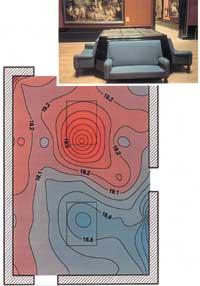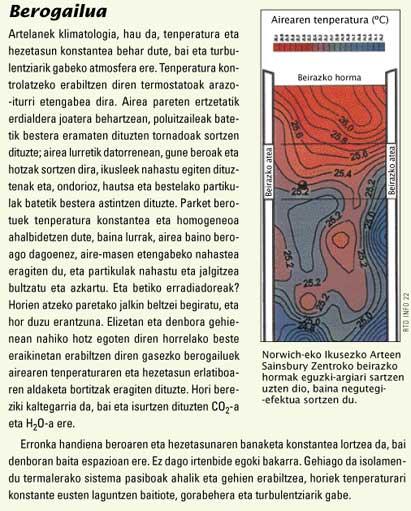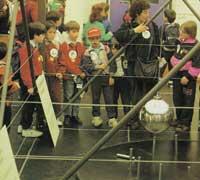Measuring the environment of museums
2002/02/01 Imaz Amiano, Eneko - Elhuyar Zientziaren Komunikazioa Iturria: Elhuyar aldizkaria

The aim of the European AER project is to analyze the complex implications of the technologies used in museums and the increasing number of spectators in works of art. Since 1996 microclimatologists, chemists and microbiologists have worked as a team under the supervision of Darío Camuffo.
Scientists decided to work simultaneously in four totally different museums in Europe: In the Museum of Visual Art of Norwich, located in St. Mark's Square in Venice (located on the coast, receives numerous visitors, with a very special climate in the Po Valley and exposed to pollutants emitted by the industrial estates of the area), in the Sainsbury Centre of Norwich (modern building of glass and aluminum, headquarters more than a mere exhibitor of the Conch 2 ‘classical’ museums of the 20th century). The study is designed to identify the most sensitive places, measure risks, propose solutions and, more generally, develop a guide to good practices in support of conservationists and architects.

In the words of Dario Camuffo, “the multidisciplinary approach is essential if you really want to give maximum protection to cultural heritage. In each of the rooms studied, as they will affect art, one must understand on the one hand the thermodynamic phenomena that control thermal and hygronomic variables, and on the other, follow the signs of chemical or biological pollutants transported by air movement (…) This type of groups require a great job. Each team member must always have basic knowledge of the discipline of others.”
Measurements

There are many variables at stake: spatial changes in temperature and humidity, condensation in micropores and deformation of jobs, dispersion of chemical contaminants and mass air transfers, influence of light and radiation, precipitation of suspended particles, detection and identification of chemical contaminants and microorganisms. Measurements are performed with maximum precision. For several days (preferably two a year, in winter and summer), microclimatologists systematically analyze headquarters using sensors, measuring temperature and humidity in different days and places.
The data is then entered into computers and used to make a three-dimensional image of the atmospheric conditions of the headquarters. At the same time, chemists and microbiologists take samples to perform laboratory microanalysis and identify harmful substances.
Results
Although the tests have not been completed, some conditions may be highlighted that are not appropriate. In the Museum run, heating and air conditioning system generate harmful cycles at temperature and humidity level. In suspension there are too many particles that can be deposited in the paint fabrics. Moreover, most of the particles are rich in calcium (released from plaster walls) and calcium is especially harmful. The situation is aggravated by carpets and vacuum cleaners, as well as frequent shocks of curtains. Chemical and biological analyses have also found elevated levels of ozone and sulfur compounds, as well as lipophilic bacteria that feed on paint fats.

At the Sainsbury Centre for the Visual Arts in Norwich, measurements have shown that the overall design of the building seeks the well-being and pleasant aesthetics of people and not an adequate microclimate that can influence works of art. Metal and glass structures (supported by the ventilation system) generate a totally unstable atmosphere. And that would be the main engine of the ‘stress’ of works of art if they were not protected with plexiglass. In short, as for the internal content, the environmental health of this modern showcase is no better than that of the museums existing in historical buildings.
“Concrete solutions can be sought for each case. But in the field of conservation, experience has taught us that we have to be very careful and that we have to analyze the stand in its entirety, since in the rest of cases we could solve one problem but create another. We need a proper balance, and that’s not easy.”

Air conditioning and humidity controlAir conditioning systems emit cold air. If the device is near the ground, the cold air that is pumped is distributed horizontally, since it is denser than the rest, progressively raising the ‘layer’ that separates this cold air from the rest. In addition, visitors emit CO 2 and water vapor at a much higher temperature, which rises and accumulates at the upper levels of the venue. If the air conditioner is on the ceiling, the cold air rushes like rain, so it mixes with the ambient air and breaks the thermal balance. Although cold air can be gently separated, air movements around the devices generate convergences. Moisture control devices create steam mists or dry air. The ideal is to be located in the center of the headquarters and not close to the most valuable works, as many times can be seen. |
LightingExcess light, both natural and artificial, can cause the greenhouse effect and, in addition, all artificial lights contain destructive components. Ultraviolet rays destroy pigments, act on organic fixers and accelerate oxidations and other chemical reactions. Visible light causes heating, drying and expansion of the structures. And infrared light equal or worse. All these damage can be avoided using optical fibers. Another important variable is the location of the light source. Direct light overheats works of art and produces dehydration. The installation of light at the bottom generates an ascending current that leads to artistic operations of dust and other particles in the air. To cause the least damage, the light source should emit rays of spectacular frequency, low intensity, blurred and from top to bottom (if on the ceiling we do not have some cool like cow). |

Gai honi buruzko eduki gehiago
Elhuyarrek garatutako teknologia




